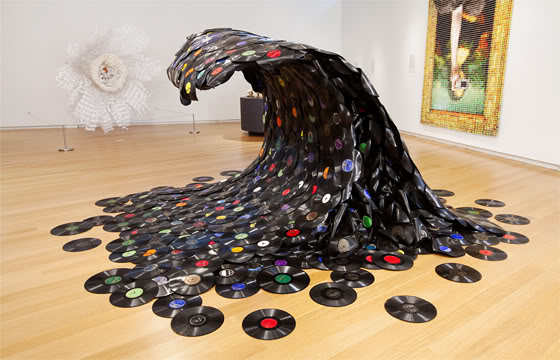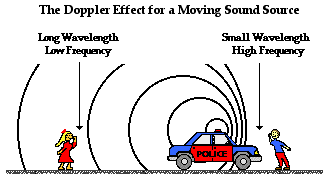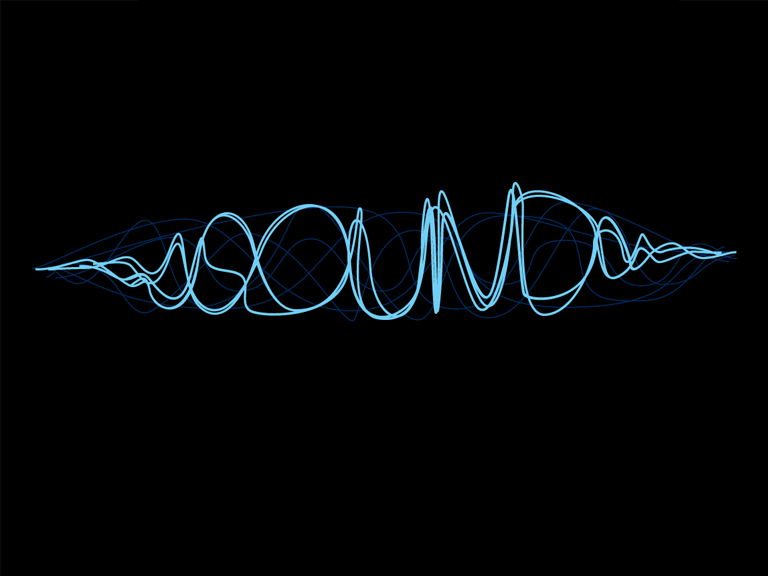- Hiya. How're you? I'm good, and I kinda...sorta...hope you're okay too. Really, it depends on the person reading the blog. Now, today is about more waves, but we're going to be focusing on one wave in particular, so I'm not going to be repeating much. Just some, 'cause, you know, in that other blog I wasn't supposed to talk about the difference between noise and sound, though I'll include it in this one, too...enough chit-chat, let's get started.
 |
| Come on, you have to admit that's cool |
Sound waves are characterized into four main parts, but there are many more, such as intensity:
- Frequency: the number of waves produced by a vibrating sound per second. Measured in hertz.
- Amplitude: Distance between the midpoint of the wave and the crest.
- Waveform: the shape and form of a signal, like a wave, that moves in a physical medium.
 |
| Sine, square, triangle, and sawtooth waveforms |
- Phase: indicates a certain point in the cycle of waveform. Measured in degrees.
- Intensity: a measure of how forcefully an object vibrates. Measured in decibels. Every increase of ten decibels causes ten times increase in wave power. The rustling of leaves produces a sound of ten decibels. A whisper has a thirty decibels. A typical discussion usually produce sixty or sixty five decibels. A vacuum cleaner can have seventy five decibels. A lawn mower can produce one hundred decibels. Lots of traffic in the city has a sound that can be as loud as eighty-five decibels. Jam-packed nightclubs can go up to one hundred five decibels, and a rock concert is usually about one hundred twenty decibels. A jet taking off produces about...oh, one hundred fifty decibels.


How does the wavelength of a sound waves affect the diffraction of the sound wave through an open window. Diffraction means the spreading out or bending of waves in the face of an object. So, the amount of defraction depends on the wavelength and the size of the object. So low frequencies, which has a long wavelength, 'diffract' around corners.
Ever wonder how echolocation could be used to measure the distance to the bottom of the lake? Well, first off, what is echolocation? Echolocation is the location of an object or objects by reflecting sound. It's mainly used by dolphins and bats. Now, human echolocation is used by people to notice objects in the environment by sensing echos from said objects. Sonar is used to measure water depth. A transmitter sends out a short pulse of sound, and the reciever gets the refelcted sound. The depth of the water is found out from how much time has passed between the time the ultrasonic wave was released and the recievance of its refelction off of the bottom of the ocean, sea, or lake.


Okay, so how does the spacing of particles in a sound wave change as the amplitude of the wave decreases? Well, when you space out the wave, the amplitude decreases. So, in other words, when the amplitude decreases, the space between the waves increase. It's really easy if you think about, and there's no other way to explain it.
So, how does the wavelength of a sound wave change if the frequency increases or decreases? If the wavelength is reduced, then the frequency has to increase to balance it out. Another way to look at it is: the frequency of a wavelength changes with the wavelength depending on what happens to the wavelength. For example, if the wave length is doubled, the frequency is cut in half, and vice versa. So when it has higher freqency, it has a higher sound, and again, vice verca.
Have you ever been at school (what did you do? and why did you tell them I was here?), or at the park and heard a siren from an ambulance, police car, or fire truck? When that happens, you usually hear the pitch of the sound from an ambulance siren get lower, then higher. What is the motion of the ambulance relative to you?
The ambulance releases a sound at a constant frequency as it moves towards you. Constant freqency never actually changes, even though it sounds like the frequency is higher than what you're used to. Remeber: higher pitch equals higher frequency. So the frequency is the same, but the wavelength is compressed in the direction you're in because the ambulance is moving towards you. To your ears (misinformative things, they are), the compressed wavelength is the same as a higher frequency pitch. But when the ambulance passes you, as soon as it does, its velocity away from you causes the pitch to expand, which makes it sound like it has a lower frequency pitch. Who knew that an ambulance passing you was so complex? But once you know it, it really does make sense.
All that is called the Doppler effect. The Doppler effect is "an increase or decrease in the frequency of sound, light, or other waves as the source and the observer move toward or away from each other." That is an incredible definition, and easy to understand. But, in other words: The Doppler effect is an increase or decrease in the amount of waves that pass a given point per second when the object and person either move towards each other, or away from each other. Yeah, I'm not good at that. But that's the Doppler effect. The pitch of a sound, when it's either high or low, is determined by the frequency of the sound waves as they hit your eardrum. Again, a high pitched sound is caused by sound waves that have a high frequency, and a low-pitched sound is caused by sound waves that have a low frequency.


Now, what causes an echo? An echo is created when sound bounces off things. Of course, you probably knew that. That's not the only thing that causes an echo, though. After all, when you scream in your bedroom, it doesn't cause an echo, even though the sound is bouncing off the walls. Sound travels fast, about three hundred meters per second. Not as fast as light, but still, pretty darn fast. An echo that's really cool and good will come back to you after a couple seconds...that's the echo that'll scare Kate and Celine, because that echo will be eerie. To get a good echo, though, the sound needs to bounce of something at least seventy five meters away, otherwise it'll come back in less than half a second, and it won't make a very good echo-o-o-o-o-o.
There's more, though. You can yell at a building seventy-five meters away until you die and still not get an echo. Why? Well, what has to happen is that a lot of the sound has to bounce back. What happens usually is that the sound exits your mouth, and travels for a while until it finally hits something. But the sound doesn't come out of your mouth in a strait line...it spreads in all directions. So only a little bit of your voice hits the building you're yelling at. If the building is too small, or your voice too low, very very little of your voice will hit the building. So it really doesn't matter if the sound bounces back or not. Even if it does, it will probably be too low for you to hear an echo.
Worse, many solids don't bounce the sound evenly if they're rough. So the little bit of your sound that reached the building gets pushed and scattered in every direction possible.
So how do we hear an echo? To get an echo, sound has to follow a rule of reflection: it says that it will bounce at the exact same angle that it hits. If you want any sound that hits the wall to bounce back to you, it has to follow that rule. But it'll only work if the surface you're bouncing the sound off of is smooth.
Even after that, you probably still won't hear an echo, because there isn't enough energy from the sound coming to your ear. So the echo is too soft, and will most likely be covered by all the sounds around you...wind, birds, cars, people, electronics...so much sound. You could, of course, hear the echo if all the sounds were quiet other than the sound coming from the wall. That can happen. Those sounds can be absorbed and never reach you if every sound around you had some sort of sound-deadener on it. That way everything would be quiet except for that sound coming to you from the wall. What's white, silent, and acts as a sound absorber and blanket? Snow!
You probably notice that it's always so quiet after the snow stops falling. That's because the snow absorbs most of the sounds that are supposed to be travelling to you. That's a great time to get an echo anywhere in your yard. Shout at the building across from you. The sound that you can hear is only a little bit of the sound that bounced back from the building. There's more, though. I mean, you can't do that in the summer. Unless you go halfway across the world. You can, however, hear echos, even in the summer. How, though? There's no snow. To get an echo in the summer, you need something to amplify that. If you could get more, you could get an echo, even on a hot, noisy day. What you need, after the sound bounces off the wall, is something that it can bounce off of again. You need multiple walls or other flat surfaces that'll bounce more sound to your ear.
So the sound that bounced of the wall comes back with more of your voice that bounced off the other walls. Or, what you can do, is go into a big, empty house and shout, echo-o-o-o-o-o-o-o! Now, we're almost done. All we need to know now is the difference between sound and pure noise. A lot of sounds are too high pitched or too low pitched for the human ear to hear. Almost everything creates a sound, even though we may not hear it. Sounds come in many forms: it can be from music, speech, and other things like film dialogue. A major thing to do with this is that we can increase or decrease the volume depending on our tastes with radio, television, movies, and other things made by man.
However, noise is a horrible, irritating, and annoying sound, because in noise, different sounds are mixed together in a wild manner. It is really hard for the ear to create sense of the sounds that it hears from noises. If a person receives too much, noise can be deafening and extremely unhealthy for a person to what a lot of people call 'noise pollution.' Sound and noise are viewed differently, usually with sound looked at as something that causes pleasure. But when sound gets too loud or combines with other sounds, that's when noise comes in.
And that's it! Sorry it was a bit long, and sorry I rambled a bit on the echo stuff. I thought it was interesting and cool. Now, as always, there are links to my classmates' blogs down below, and also more links if you want to know more about this sound wave stuff. Did you know that the average human can only hear sounds uo to one hundred twenty decibels? Pretty cool, huh? Er...sorry. There's also a link to a video SuperSara loves below. The video won't show up on the blog...don't know why. Anyway, thanks for reading my blog, folks! Or, thanks for being forced to read my blog, folks! Bye for now-ow-ow-ow-ow!



















Don't even say it's a long blog. I know it is. I GET it. It's supposed to be informative, not SHORT. Geez.
ReplyDelete